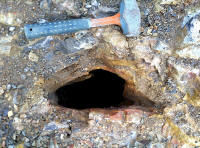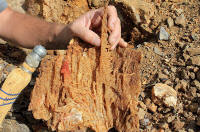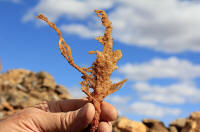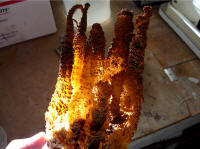Feather Ridge and Linda Marie Plume Agate Digs
(9-2013/10/2013)
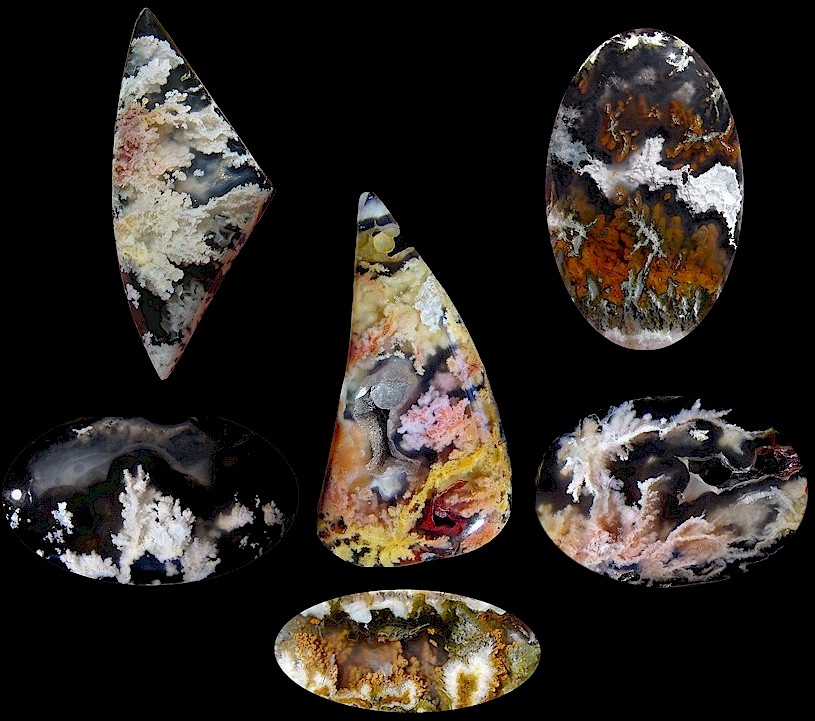
Feather Ridge 9/13/2013
The October weather in the Owyhee’s was perfect for mining. However, it was tough getting up every morning before sunrise. It gets rather cold in the mornings and these old muscles take awhile to warm up and start firing correctly after a hard day of mining the previous day. But after a few Advils, hot cup of tea and a bowl of Oatmeal, everything starts moving, the brain, legs, arms, fingers…intestinal track.
I first started digging at my Feather Ridge claim. Before digging, I went for a consultation. The “professional hard rock mining consultant” (Jake), and I discussed the trends in and on the ground to determine the best places to begin. But first, we agreed I should do some “scratching” in those target areas. Scratching is when you take the teeth on the excavator bucket and lightly scrape/scratch about 10” back and about 10” deep of the surface to determine where the rotten basesalt is in relation with the hard basalt. At both mines, determining rotten basalt and hard basesalt gives you a good idea where the ancient hot water vents are located.
A hot water vent is where the mineral rich hot water bubbled to the surface, much like the vents you see in Yellowstone today. I have uncovered two such vents during my first dig at Feather and one so far at Linda Marie. During October’s diggings, I uncovered a huge one at Feather which I’ll talk about later. To keep it simple and a long geologic story short…the plateau basaltic flows formed in the Owyhee area about 32 million years ago. Then along comes a caldera which started near McDermitt, Nevada 18 Million years ago, which is on the Idaho/Nevada southern border.
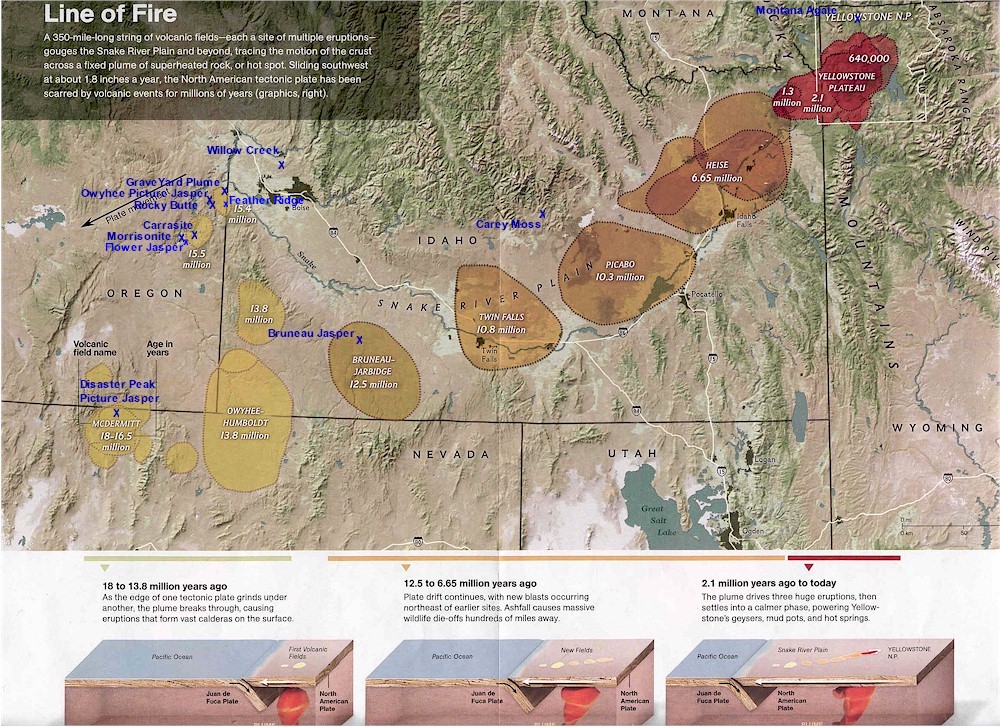
The Rotten Basalt
So, getting back to the rotten and hard stuff. The rotten basalt is located around the vents and is generally softer but does contain agate veins. I have found that in these rotten basalts and yellow ash is where I find the botryoidal and a great deal of opal. It makes sense, I guess, to find vast amounts of opal around the vents, since opal is formed at low temperature and contains 6 to 20% water.
I start digging a trench at one of the “scratch” sites, then begin to see the fascinating geologic separation of the younger intrusion up into the older hard basalts and with it the colorful pink and yellow plume agate-filled veins. An interesting formation in all this is the large boulders of basalt in the flow basalts.
These basalt boulders have layers around them, much like an onion which you can peel off. Sometimes agate forms inside these layers and around the boulders. When I pointed this out to Jake, he said, “Yeah… interesting…but a damn pain in the ass”. I agree. It’s a pain trying to pluck these very large 200 to 400+ pounders out of the hard basalts, since they can get very disruptive when you hit one while trying to scoop out the muck.
In just a short while, I uncover a hole near the surface where I was scratching. I get out of the excavator and walk to the bottom of the trench and see a two foot diameter hole. Definitely, another gas vent. I flash a light down into it and see it goes down about 12 feet and is lined with angel wing formations. To my surprise, hanging down from the ceiling are agate stalactites! Some stalactites are about 8” long, some in clusters and some individuals. I see a long stalactite. I stick my arm into the hole and touch it with my hand. Then I give it a light flick with my finger and it rings like a small bell. Luckily, I can dig around the opening with the machine to expose the complete vent and remove some of the angel wing plates intact.
Generally, angel wing does not have plumes in the agate, but when it does, they’re not very long, maybe about 5mm. Most of the agate plates have small wheat colored plumes, but not long enough to be cabbed. I gather about two dozen good wing plates for display specimens and a few still have the stalactites on them
SCREECH! CRACK!
Continuing to dig out the trench, I keep hitting and bouncing on what I think is an irritating basalt boulder. Every time I drag the bucket full of muck out of the hole, I hit the SOB boulder. It is starting to piss me off, so I ram the bucket teeth down hard behind where I think its hiding and give it a hard pull. This actually lifts the excavator’s back end up. Then SCREECH! CRACK! It gives, flinging up dirt like a small explosion, sending the back end of the excavator pounding down hard on the ground. A huge agate flake about two feet long and a foot wide flips up in the air and lands face up in the trench. It has 3” long pink plumes lined on both sides. “Holy Crap!” I look down in the trench and see a giant vain exposed in the bottom wall with the Agate flake next to it.
Ambling down the trench, I can see a giant vein running vertically down into the ground. Removing some of the muck around it, I can see the scrap marks on the agate where I’ve been hitting it with the bucket. Looks like the vein stuck out from the wall about two feet and that’s what I’ve been hitting all this time.
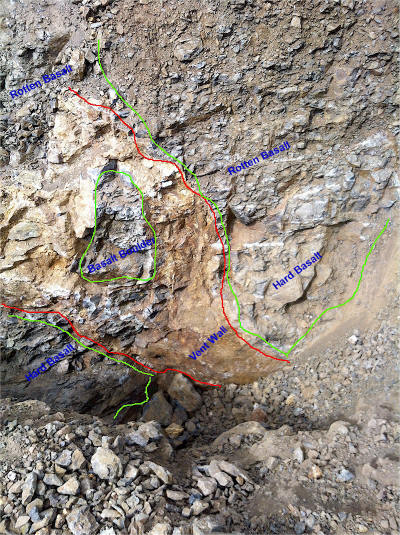
Vent Wall and Basalts

Vent in yellow and me pointing to the (15 x 5 x 5)
Angel Wing and Stalactite opening
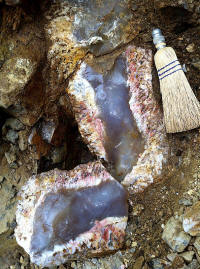
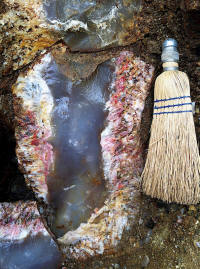
Digging more around it with the machine, I can uncover about four feet of it and it’s still going down! At this point, I’m really too deep to dig it all out this time around. So, I remove as much as I can and move on to other exposed veins. I can’t spend too much time on it, because I’m the only one out here and my days are limited. I am spending seven days out here, but have only five good digging days. The first day is spent digging out the old muck and then setting up the “pad” which the machine sits on. Then, the last day is devoted to filling in the hole and modifying the surface for erosion control and reseeding.
All in all, I dug up some really good plume for the little time that I have spent here at Feather Ridge. Luckily, my good friend, Frank Masley, came by and helped me load all the buckets up, break camp and walk the excavator over to the Linda Marie claim. Frank was there when I needed help and I appreciate him a great deal. A long time customer of mine, Kelly Cooper, came out for a few days all the way from North Dakota to visit and help out. Kelly also took some pictures, some of which are posted here. Thanks Kelly.
